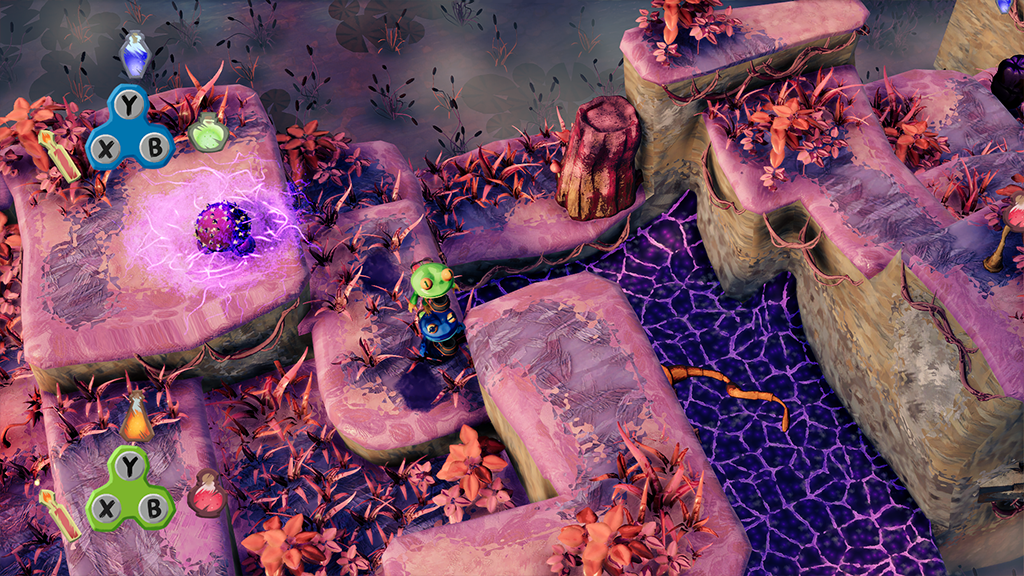Alchemy Frogs
Alchemy Frogs
3D isometric 2 -player co-op puzzle-platformer in which Toad and Frog, equipped with their porta-cauldrons, free their swamp from a mysterious plague.
You can find it on itch.io or on steam!
The goal
In a team of 6, being given 2 months of pre-production time (minus the classes) and 4 months of production time (also minus the classes), achieve the most complete and polished 10-minute game experience we could.
My contributions
- Participating in the design of the game. Of course, this being a game design final project meant all team members had to contribute equally to the design, at least during pre-production. I was especially proud of my contributions to our documentation: I adore writing game design documents and communicating design ideas. We got several top marks during all of pre-production because of our exhaustive documentation.
- Keeping track of the project advancements, and making sure we would be able to complete our milestone goals. I am a very organized person, and I like when the team’s objectives are crystal clear. Overall, I think this trait of mine benefited our team by releasing us from the stress that comes from nebulousness and surprises.
- Helping my teammates! Since I have a background in Computer Engineering, I am very familiar with programming and mathematics. Thus, I assisted our programmers where I could. I also had experience with shaders (I love working with shaders!), that I used in various occasions, whether it was to design the step-colour shader we used over all of our props, or to make the blend layer shader that utilized vertex painting as a way to slap some texture over our ground meshes. I helped my fellow artists to accomplish many tasks, related to VFX, shaders, modeling, texturing or UVs.
- Creating almost all of the game’s environment/props, modeling and texturing included. Being the environment artist on our team, it was my main responsibility during production. I was really excited to be assigned that role, because the art pipeline was the big unknown for me when I started VFS. Thus, it meant that I got to familiarize myself with the daily tasks of an artist. Ultimately, I know this will help me to be a better designer and communicator.
- Coordinating our 2D art collaborators: we had 4 additional art contributors on the team, and being the environment artist, I was well-positioned to give them tasks, communicate our priorities and due dates, review their work, and answer to their punctual questions. I loved, loved that aspect of my work on this project, and our collaboration went as smooth as butter.
Game Design Stories
No inventory crafting
The game started as an exploration and crafting 2-player co-op experience. We all loved exploration games, and crafting systems have strong fascination powers over our team members. But, our instructors kindly let us know that inventory systems were out of our reach, unless we wanted to make a game revolving around its inventory, and that crafting systems, for a 10-minute experience, would poorly display our skills. Thus, we came up with the idea of a typing game: the alphabet on our keyboards, after all, is a ready-to-use, convenient and limitless inventory of all 26 letters. Later, we downsized to the directional arrows in order to use the same system on our controllers.
Minimalist puzzles
We had planned for very little puzzle elements, albeit we were making a puzzle-platformer.
The thing was, we only figured we were making one a week into production. Before that, we had the intention of having a forced-scroll, obstacle course game. That concept blended well with the typing game imperative of putting pressure on the player to craft words quickly. However, we collectively realized that having a forced-scroll element to the game was taking away from the good vibe experience we wanted for our couch-co-op, “enjoy the presence of your friend” original vision. We wanted a game where the players could breathe, talk with each other and would not be frustrated by the potential lack of skill of a player. The challenge had moved from the pressure to the reflection.
Thus, we made a list of our potential puzzle pieces:
- Push blocks
- Elevation
- Keys and locks (or potions and switches, in our case)
- Pressure plates
- Deadly pits, proximity traps, timely hazards.
Suddenly, we realized that we had plenty. Sequence puzzles. Agility puzzles. Deduction puzzles. Timing puzzles. We just needed to combine a few of those pieces, in different orders, to create new combinations to crack. And so, we did!
